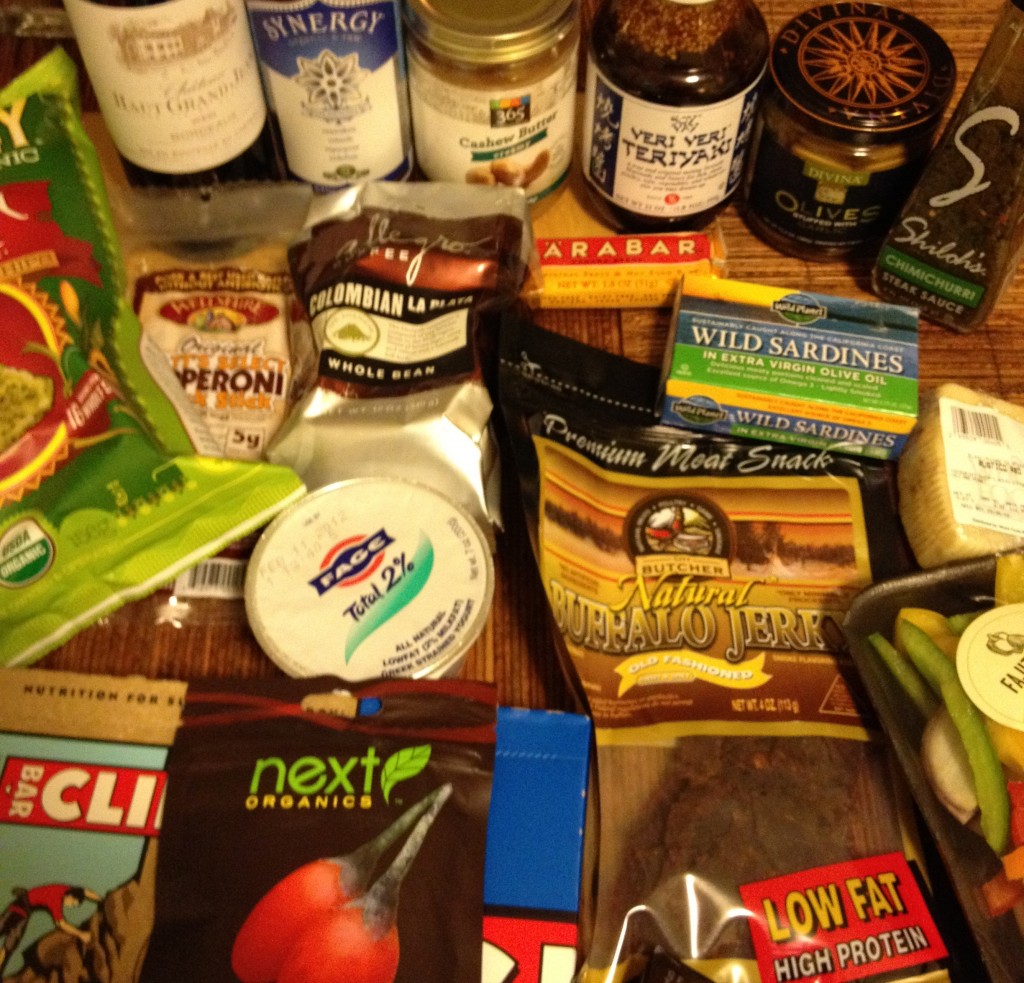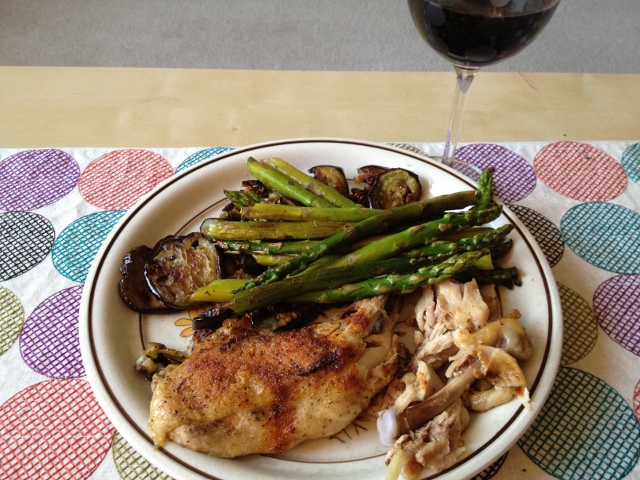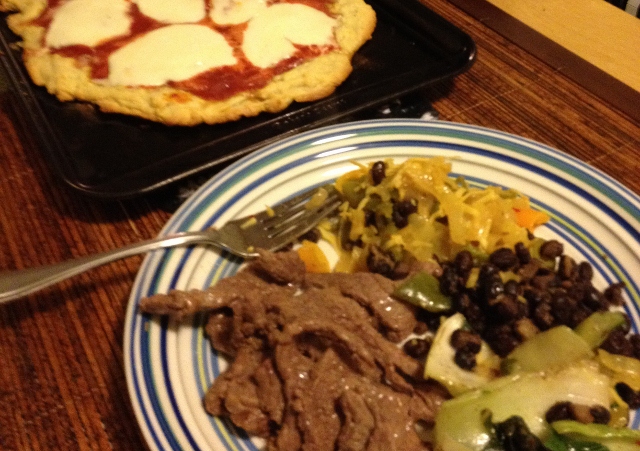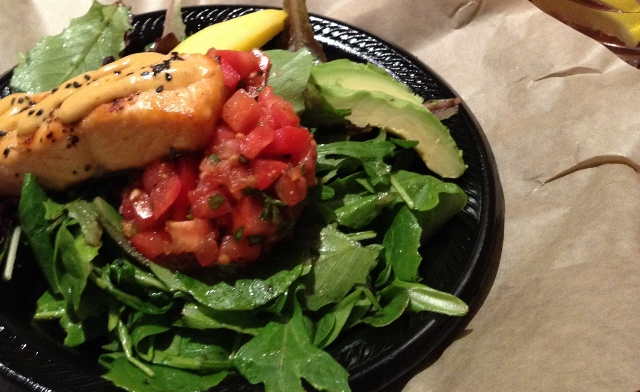This is what happens with a Wholefoods gift card. I go crazy like a kid in a candy shop – or like a food fanatic who can’t control his craving for healthy, delicious snacks.

But I used to be a glutton. Being naturally skinny, I never had to worry about eating crappy food because I never worried about weight loss. Running throughout high school and college only reinforced my bad eating habits. I had no idea what a healthy diet for a runner should look like.
It’s somewhat embarrassing, but I want to tell you a quick story about my favorite time of day as a freshman in college. You might be thinking, “Saturday night!” or “Race day!” or maybe even “When Jason had class with that hot girl he had a crush on!”
Unfortunately, none of those are true. Being 99% residential, Connecticut College had a damn good dining hall and an unlimited meal plan.
Every day, I looked forward to dinner after cross country practice like a normal person does with Christmas. I had also learned that the human body doesn’t register the feeling of fullness or satisfaction from a meal until about 15 minutes after you start eating. So I loaded my tray with a big plate, several smaller plates, and at least one bowl – all full of food.
Then the eating would start. I literally loved to stuff my face full of whatever they were serving:
- chicken breast sandwiches with double cheese, ranch dressing, and bacon
- pepperoni pizza dipped in ranch dressing
- barbecue pork subs with french fries
- pasta with meat sauce and melted cheese
- hot dogs, cheeseburgers, and more Lucky Charms than is reasonable or sane (I LOVE cereal)
Clearly, I had a problem. I was like the sheltered home-schooled kid who went buck wild and couldn’t contain his partying once he was set free from the parental leash. Except with food.
Fast forward to February of my Senior year. I had a physical over Winter Break and my lab work came back with a startling result: my total cholesterol was at 211 (under 200 is considered healthy) and my LDL and HDL levels were all out of whack.
After over 22 years of pristine health, I came to the unfortunate conclusion that I was not immune to the side effects of a shitty diet. Despite a healthy weight of about 132 pounds for my height of 5′ 7″ and high levels of exercise, I wasn’t as healthy as I could be.
The saying, “If the furnace is hot enough, it will burn anything” isn’t quite true – it clearly wasn’t burning through the excess cholesterol floating through my body. While cholesterol isn’t a great indicator of overall health (I now think slightly high cholesterol isn’t something to worry about), it made me realize that I needed to make some changes.
Change Your Food Mindset
Over the years, I’ve refined how I think about food and the best diet for runners. Personally, I don’t believe in traditional diets – unsustainable cuts in calories, dramatic changes in eating habits, and a refusal of anything that might be considered unhealthy.
I don’t consider that fun nor do I think it’s the best long-term solution for weight management or optimal health.
With training being consistent over the years, what’s changed to help improve my blood panel, racing weight, and strength to weight ratio? I certainly haven’t been on a diet for the last 6 years. Instead of a restrictive meal plan, I’ve developed a new mindset about food.
It helped improve my total cholesterol from 211 in 2006 to 184 in 2010 (measured again at 185 five months later). My racing weight is about five pounds lighter at 127 today – even though I’m a lot stronger.
I still eat almost whatever I want – but I pick my battles. What’s changed is that I now understand what’s good for you and what’s not. Before I never knew! I’ve learned from:
- The Primal Blueprint by Mark Sisson
- In Defense of Food by Michael Pollan
- The Omnivore’s Dilemma: A Natural History of Four Meals by Michael Pollan
- Fast Food Nation by Eric Schlosser
- The Four Hour Body by Tim Ferriss
- The Paleo Diet for Athletes by Joel Friel and Loren Cordain
- Fat Head starring Tom Naughton (movie)
Diet for Runners: The Top 5 Food Rules to Live By

I’m usually not a fan of “rules” that deny you things that you enjoy. Yet these five principles of healthy diet for runners can dramatically help you change your eating habits for the better without much sacrifice. I’m a realist when it comes to diet but these rules might just change your life.
By the way, a daily dose of Athletic Green’s AGI is like “nutrition insurance” to help you find peace of mind that you’re getting the nutrients you need!
1. Stock up your house with real food. The term “real food” means minimally processed with as few ingredients as possible. Think:
- High-quality meat (local, organic, or grass-fed if possible)
- Vegetables
- Fruit
- Beans
- Nuts
- Wild rice or quinoa
By stocking up on real food, you’ll need to get rid of all the processed stuff and junk food. Here’s your chance to have some fun: don’t throw it away, eat it! Have a cheat weekend where you only eat junk food and processed food.
Not only will you rid your home of unhealthy food, you’ll be craving the healthy stuff.
2. Don’t be a zealot – cheat on your diet regularly. Perfection can be the enemy of the good and you need to let yourself enjoy food that you love. What you usually do is more important than what you sometimes do.
Remember that your diet can be more flexible after long runs or hard workouts. Your body is craving more calories and carbohydrates so cookies, a cheeseburger and fries, or slice of pizza can actually be a good thing.
I usually have a bowl of ice cream every night. And I love it – no regrets.
3. Cut back on your sugar intake (but be realistic about your carb needs as a distance runner). Every runner knows that carbohydrates provide the best fuel for running and that most runners don’t carbo-load for the marathon properly.
But on a day to day level there’s no need to consume so much sugar. Do you really need a 32 ounce Gatorade after your easy 5 miler? Are two plates of spaghetti necessary on a day you didn’t run at all? You know your body best but if you’re struggling with weight issues then excess carbs could be the culprit.
4. Vegetables are the best food group for you. They’re calorie poor, nutrient dense, and usually have very little sugar. You should try to eat at least two servings a day.
My challenge to you: have 1-2 servings of vegetables at every meal for a week. Here’s how.
- [Breakfast] Whole-egg omelette with chopped mixed vegetables
- [Lunch] Big ass salad
- [Dinner] Paleo spaghetti with chicken breasts and a side of wild rice
5. Enjoy your food! Try new things, cook differently, use wacky spices. Sautee your vegetables instead of boiling them. Bake them instead of sauteing. Use a crock pot instead.
Get a spice sampler to make sure you experiment with new flavors. Or, try ordering some different types of meat from a reputable vendor.
Food can be a fantastic way of exploring the world. Don’t let yourself get stuck with the same 4 meals.
My Typical Daily Diet

Marathon Training Meal: homemade pizza, sauteed beef, bok choy, black beans, mixed vegetables in coconut oil
Eating right doesn’t have to be difficult or a chore to plan. I enjoy the process of cooking and usually only spend 30-45 minutes preparing dinner.
There’s no single best diet for runners, but this is what my typical daily diet looks like.
Breakfast and mid-morning snack
- Banana, coffee with whole milk, two whole eggs scrambled with mixed vegetables and cheese
- Handful of cashews and a serving of full fat Greek yogurt with honey
Lunch and mid-afternoon snack
- Small spinach salad with cheese, cucumbers, shredded onions, and carrots
- Leftovers: sliced chicken breast, mixed vegetables sauteed in olive oil
- Cottage cheese
- Apple
- Peanut M&M’s (my Kryptonite) or a few pieces of dark chocolate with almonds
Dinner and post-meal snack
- Chips and guacomole or pita chips and hummus
- Baked eggplant in olive oil, pan fried asparagus, ground beef with beans
- Bowl of ice cream
- 1-2 beers or glasses of wine
Damn I eat a lot. I’ve never kept a food journal but I can see why it can be so valuable! Just by writing down my typical daily diet I see that I eat a lot of dairy. It doesn’t bother me but it can cause stomach issues for some who are more sensitive to lactose; be careful with all the cheese, milk, and ice cream.
It’s also important to distinguish between “typical” meals during regular training and meals during heavy marathon training. The picture in this section is a “marathon meal” – with a homemade pizza and black beans. During periods of heavy volume I’ll try to add 2-3 more servings of carbohydrates per day.
I usually stick to better sources than pizza like quinoa, wild rice, beans, or whole-grain bread. But I’m not too picky when I’m preparing for a 22 miler with 9 of those miles at Marathon Pace.
3 Diet Hacks for Runners: Performance, Weight Management, and Recovery

High fat, low carb: arugula salad with tomatoes, salmon, avocado
There are three “hacks” or diet strategies that you can use for specific situations in your training. I use these depending on where I am in my training cycle, how I feel, and my goals at the time. You can too.
How to optimize performance: If you have a big workout or long run planned that you really want to nail, you can make a few tweaks to your pre-run meal to help you kick ass.
First, make sure you’ve eaten enough carbs. Right before you run it’s fine to eat simple carbs (like pancakes or toast) since you’ll be using it very soon as fuel to run fast.
Second, drink some coffee to help you feel better and run faster during your workout. Be cautious if you don’t normally drink coffee since it can…ahem…make you need a bathroom. If you’re used to its effects, 1-2 cups about an hour before your workout can help you run faster by improving focus, changing how your muscles contract, and blunting your perception of pain.
Make another fresh pot! Giddy up! [Click here to tweet this, you caffeine addict]
How to lose weight: Being at your goal weight is an important part of running well. You’ll only run slower if you’re carrying unneeded pounds so determine your optimal weight and make it your mission to get there.
A simple and relatively quick way to drop unwanted weight is to eliminate almost all sources of carbs from your meals. A Paleo diet isn’t 100% compatible with heavy training but you can do it while running easy for most of your workouts.
If you are running a lot, I highly recommend The Paleo Diet for Athletes for advice on how to time your carb intake to fuel your workouts (not your thighs).
How to avoid over-training: The feelings of over-training can hit you like a sledgehammer: fatigue, soreness, lethargy, and poor performances in your running workouts. But to quote Mark Sisson, “Sometimes, over-training is actually just under eating.”
Food is fuel and if you’re not giving your body what it needs it won’t recover and heal itself. You’ll feel the consequences during your next run. One of our RYBQ members was dealing with this issue while simultaneously trying to lose weight by restricting her diet and training for a marathon.
You can’t do both. If you’re feeling worn down and overly fatigued, cook a few hearty meals and eat more than you normally would. And of course, sleep is the best recovery tool you have so get a lot of it. After a few days you’ll probably feel refreshed and re-energized to tackle your running.
What now? 4 Ways to Reinvent Your Diet Today

I want to leave you with four action steps that you can do today to improve your diet.
1. Recruit your team. Whether it’s your roommate, husband, mom, dad, wife, or girlfriend – you need a support team to kick ass. They’ll remind you of your goals and keep you in line when you start to stray. Make sure they’re not bringing boxes of Lucky Charms into the house or – if you’re like me – you’ll eat a box in one sitting.
2. Clean out your fridge, freezer, and food cupboard. Yes, you can do that by eating all that gross stuff. This is your last hurrah. Enjoy it. It’s just too hard to stick to healthy, whole food if you have a package of Chips Ahoy in your cupboard.
Once all that junk food is in your stomach, you need to replace it with the good stuff.
3. Take an “all in one.” I’m not a big fan of supplements but I do love AG1 by Athletic Greens. It’s a greens mix, probiotic, prebiotic, adaptogen, and has 75 vitamins and minerals.
Plus, it’s approved for sport and is certified gluten free. It’s my no-brainer insurance against poor nutrition.
Get it here and you’ll also get 5 free travel packs and a year’s supply of Vitamin D!
4. Make a “master” shopping list. A master shopping list includes all of the essential items that you’d buy at the grocery store. It’s not necessarily what you buy every time you go shopping – but it’s what you refer to if you need ideas on what to buy.
Keep it handy and use it to create smaller lists of things you need on a weekly basis.
To help you out, I’ve partnered with a Registered Dietitian (and marathoner) to create a free nutrition course for you. It also includes a massive master shopping list with almost 90 ideas for your next shopping trip – everything from veggies and fruit to seafood and grocery items like Sunbutter and guacamole.
Use it anytime you’re wondering, “What the hell should I eat tonight?” It’s bound to give you a few great ideas for dinner.
Simply sign up here and the first lesson will be on its way.
There are countless diets for runners and you need to find what works for you. These strategies have worked for me by improving my body composition, helping me feel better, and improving my blood panel results. Whether you’re full Paleo, Vegan, Vegetarian, or a more conventional eater – what food rules have worked for you?
Bon appetit!